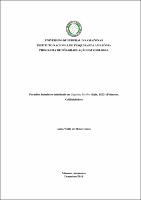| ???jsp.display-item.social.title??? |


|
Please use this identifier to cite or link to this item:
https://tede.ufam.edu.br/handle/tede/7653Full metadata record
| DC Field | Value | Language |
|---|---|---|
| dc.creator | Gomes, Adna Wally de Melo | - |
| dc.creator.Lattes | http://lattes.cnpq.br/8176132736213152 | por |
| dc.contributor.advisor1 | Gordo, Marcelo | - |
| dc.contributor.advisor1Lattes | http://lattes.cnpq.br/7974425330619510 | por |
| dc.contributor.referee1 | Oda, Welton Yudi | - |
| dc.contributor.referee1Lattes | http://lattes.cnpq.br/2950420618885200 | por |
| dc.contributor.referee2 | Barnett, Adrian | - |
| dc.contributor.referee2Lattes | http://lattes.cnpq.br/2391620576981720 | por |
| dc.date.issued | 2019-12-30 | - |
| dc.identifier.citation | GOMES, Adna Wally de Melo. Parasitos helmintos intestinais em Saguinus bicolor (Spix, 1823) (Primates, Callitrichidae). 2019. 43 f. Dissertação (Mestrado em Zoologia) - Universidade Federal do Amazonas, Manaus, 2019. | por |
| dc.identifier.uri | https://tede.ufam.edu.br/handle/tede/7653 | - |
| dc.description.resumo | Este trabalho teve como objetivo principal, avaliar a fauna de helmintos encontrada nos estômagos e intestinos dos sauins de coleira (Saguinus bicolor) atropelados no fragmento do Campus Universitário da UFAM, que se encontravam depositados nos freezers do projeto sauim de coleira no decorrer dos últimos 18 anos. A procura por helmintos adultos foi realizada nos estômagos e intestinos removidos dos indivíduos descongelados. Duas espécies de helmintos foram encontradas Prostenorchis elegans (Acanthocephala) e Subulura sp. (Nematoda), ambos novos registros para Saguinus bicolor. Foram necropsiados 59 sauins, 36 machos e 20 fêmeas, a prevalência total de infecção foi de 52,54% (31/59), 52,77% dos machos estavam infectados e 55% das fêmeas também estavam infectadas. Dos 31 indivíduos positivos para helmintos, 29 (93,54%) estavam infectados com Acanthocephala, cinco (16,12%) com Nematoda, e três (9,67%) com ambos os filos. Foram encontrados 355 espécimes parasitas, sendo 344 Acanthocephala e 11 Nematoda. Não encontramos diferença significativa quando comparamos o número de parasitos entre machos e fêmeas, e nem encontramos correlação com a pluviosidade quando realizamos as análises. Entre os exemplares utilizados havia seis indivíduos que considerei doentes, pelo histórico do livro de tombamento do projeto sauim de coleira onde eram registrados os sauins que chegavam, assim, comparando esses indivíduos com os demais sem histórico de doença a diferença foi significativa. O mês de maior incidência de parasitas foi o mês de janeiro. Uma série de fatores podem estar influenciando na dinâmica da relação parasita x hospedeiro, sazonalidade, fenologia, posição hierárquica do sauim, taxas hormonais, fatores que precisam ser melhor avaliados. A continuidade do estudo dessa relação pode ser uma importante ferramenta para o estudo da conservação desse primata ameaçado que é o sauim de coleira. | por |
| dc.description.abstract | This work had as main objective, to evaluate the fauna of helminths found in the stomachs and intestines of the Sauins de Coleira (Saguinus bicolor) run over in the fragment of the UFAM University Campus, which were deposited in the freezers of the Sauim de Coleira project during the last 18 years. The search for adult helminths was carried out in the stomachs and intestines removed from the thawed individuals. Two species of helminths were found: Prostenorchis elegans (Acanthocephala) and Subulura sp. (Nematoda), both new records for Saguinus bicolor. 59 sauins were necropsied; 36 males and 20 females, the total prevalence of infection was 52.54% (31/59), 52.77% of males were infected and 55% of females were also infected. Of the 31 individuals positive for helminths, 29 (93.54%) were infected with Acanthocephala, five (16.12%) with Nematoda, and three (9.67%) with both phyla. 355 parasitic specimens were found, being 344 Acanthocephala and 11 Nematoda. We did not find any significant difference when comparing the number of parasites between males and females, nor did we find any correlation with rainfall when we performed the analyzes. Among the specimens used, there were six individuals that I considered sick, due to the history of the tipping book of the Sauim de Coleira Project, where the Sauim who arrived were registered, thus, comparing these individuals with the others without a history of illness, the difference was significant. The month with the highest incidence of parasites was January. A number of factors may be influencing the dynamics of the parasite x host relationship, seasonality, phenology, sauim's hierarchical position, hormonal rates, factors that need to be better evaluated. Continuing to study this relationship can be an important tool for the study of the conservation of this endangered primate, which is the Sauim de Coleira. | por |
| dc.format | application/pdf | * |
| dc.thumbnail.url | https://tede.ufam.edu.br//retrieve/37021/Disserta%c3%a7%c3%a3o_AdnaWally_PPGZOO.pdf.jpg | * |
| dc.language | por | por |
| dc.publisher | Universidade Federal do Amazonas | por |
| dc.publisher.department | Instituto de Ciências Biológicas | por |
| dc.publisher.country | Brasil | por |
| dc.publisher.initials | UFAM | por |
| dc.publisher.program | Programa de Pós-graduação em Zoologia | por |
| dc.rights | Acesso Aberto | por |
| dc.subject | Parasitos | por |
| dc.subject | Saguinus bicolor (sauim-de-coleira) | por |
| dc.subject | Parasitoses intestinais | por |
| dc.subject | Helmintíases zoonóticas - Primatas | por |
| dc.subject | Acantocéfalos | por |
| dc.subject.cnpq | CIÊNCIAS BIOLÓGICAS: ZOOLOGIA: ZOOLOGIA APLICADA: CONSERVAÇÃO DAS ESPÉCIES ANIMAIS | por |
| dc.title | Parasitos helmintos intestinais em Saguinus bicolor (Spix, 1823) (Primates, Callitrichidae) | por |
| dc.type | Dissertação | por |
| dc.subject.user | Saguinus bicolor | por |
| dc.subject.user | Sauim de coleira | por |
| dc.subject.user | Helmintos | por |
| dc.subject.user | Acanthocephala | por |
| dc.subject.user | Nematoda | por |
| Appears in Collections: | Mestrado em Zoologia | |
Files in This Item:
| File | Description | Size | Format | |
|---|---|---|---|---|
| Dissertação_AdnaWally_PPGZOO.pdf | Dissertação_AdnaWally_PPGZOO | 1.55 MB | Adobe PDF |  Download/Open Preview |
Items in DSpace are protected by copyright, with all rights reserved, unless otherwise indicated.




